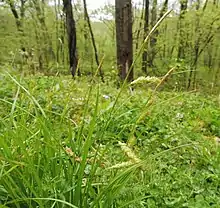| Carex cherokeensis | |
|---|---|
 | |
| Scientific classification | |
| Kingdom: | Plantae |
| Clade: | Tracheophytes |
| Clade: | Angiosperms |
| Clade: | Monocots |
| Clade: | Commelinids |
| Order: | Poales |
| Family: | Cyperaceae |
| Genus: | Carex |
| Subgenus: | Carex subg. Carex |
| Section: | Carex sect. Hymenochlaenae |
| Species: | C. cherokeensis |
| Binomial name | |
| Carex cherokeensis | |
Carex cherokeensis, commonly called Cherokee sedge,[1] is a species of flowering plant in the sedge family (Cyperaceae). It is native to the United States where it is found in the Southeast.[2] Its natural habitat is in high-nutrient, often calcareous soil, in bottomland forests, mesic forests, and wet meadows.[3][4]
Carex cherokeensis is a rhizomatous perennial graminoid. It has drooping spikes which are 8–9 mm thick. Its perigynium beaks are papery and fragile.[5] It produces fruits in late spring and early summer.[4]
References
- ↑ USDA, NRCS (n.d.). "Carex cherokeensis". The PLANTS Database (plants.usda.gov). Greensboro, North Carolina: National Plant Data Team. Retrieved 15 August 2018.
- ↑ "Carex cherokeensis". County-level distribution map from the North American Plant Atlas (NAPA). Biota of North America Program (BONAP). 2014. Retrieved 15 August 2018.
- ↑ Alan Weakley (2015). "Flora of the Southern and Mid-Atlantic States".
- 1 2 Carex cherokeensis Flora of North America
- ↑ Chester, Edward (2015). Guide to the Vascular Plants of Tennessee.
This article is issued from Wikipedia. The text is licensed under Creative Commons - Attribution - Sharealike. Additional terms may apply for the media files.